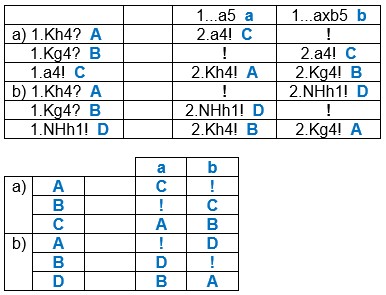|
No.1224 |
Original Fairy problems |
Definitions: (click to show/hide)
Nightrider-Hopper: (1,2) Hopper. Moves along (1,2) Rider lines stopping on the next square after the first obstacle of either color. A capture may be made on arrival, but the hurdle is not affected.
|
No.1224 Narayan Shankar Ram & |
Solutions: (click to show/hide) |
|
White Rf7 Pb5 Pf5 Bg5 Ph5 NHb4 Pf4 NHe3 NHf3 Kg3 NHh3 Pa2 Qf2 Rg1
Black Ke8 Pa6
r#5 b) -wPa2 (14+2) |
a)
1.Kg3-h4 ? zugzwang.
1...a6-a5
2.a2-a4 zugzwang.
2...a5*b4
3.Rg1-g4 zugzwang.
3...b4-b3
4.Qf2-g3 zugzwang.
4...b3-b2
5.Rf7-h7
5...b2-b1=NH #
but
1...a6*b5 !
1.Kg3-g4 ? zugzwang.
1...a6*b5
2.a2-a4 zugzwang.
2...b5*a4
3.Qf2-h4 zugzwang.
3...a4-a3
4.Rg1-g3 zugzwang.
4...a3-a2
5.Rf7-g7
5...a2-a1=NH #
but
1...a6-a5 !
1.a2-a4 ! zugzwang.
1...a6-a5
2.Kg3-h4 zugzwang.
2...a5*b4
3.Rg1-g4 zugzwang.
3...b4-b3
4.Qf2-g3 zugzwang.
4...b3-b2
5.Rf7-h7
5...b2-b1=NH #
1...a6*b5
2.Kg3-g4 zugzwang.
2...b5*a4
3.Qf2-h4 zugzwang.
3...a4-a3
4.Rg1-g3 zugzwang.
4...a3-a2
5.Rf7-g7
5...a2-a1=NH #
b) -wPa2
1.Kg3-h4 ? zugzwang.
1...a6*b5
2.NHb4-h1 zugzwang.
2...b5-b4
3.Rg1-g4 zugzwang.
3...b4-b3
4.Qf2-g3 zugzwang.
4...b3-b2
5.Rf7-h7
5...b2-b1=NH #
but
1...a6-a5 !
1.Kg3-g4 ? zugzwang.
1...a6-a5
2.NHb4-h1 zugzwang.
2...a5-a4
3.Qf2-h4 zugzwang.
3...a4-a3
4.Rg1-g3 zugzwang.
4...a3-a2
5.Rf7-g7
5...a2-a1=NH #
but
1...a6*b5 !
1.NHb4-h1 ! zugzwang.
1...a6-a5
2.Kg3-g4 zugzwang.
2...a5-a4
3.Qf2-h4 zugzwang.
3...a4-a3
4.Rg1-g3 zugzwang.
4...a3-a2
5.Rf7-g7
5...a2-a1=NH #
1...a6*b5
2.Kg3-h4 zugzwang.
2...b5-b4
3.Rg1-g4 zugzwang.
3...b4-b3
4.Qf2-g3 zugzwang.
4...b3-b2
5.Rf7-h7
5...b2-b1=NH # {
(C+ by Popeye 4.77)}
From the motivation point of view, in each variation, the 1st black move determines the square where bP can arrive in the 5th black move and White has to prepare the mating net. To this end, wK moves to correct mating square, wQ and wRg1 both block as well as unguard mating lines and wRf7 immobilizes hurdle by blocking potential arrival squares of wNHs.Mates are model and three white pieces KRQ exchange their places cyclically. From the new-strategical point of view, the content is rich thanks to twinning mechanism employed. It can be characterized by the following two tables (one including moves, the other just algebraic scheme): The content of one position is well known – doubled reversal with Banny theme for free AaCb?-CaA + BbCa?-CbB. The twin adds the second doubled reversal with the same tries, but reciprocally exchanged refutations as well as exchange of attacks. In total both defences a, b are followed by 4 different continuations. It is fair to admit that the mechanism of exchange aAbB-aBbA as well as reversal themes itself is very simple, based only on the presence/absence of two white units on a4+b4. But it means the present problem can be indeed used as an example of seemingly difficult new-strategical complex of themes achieved by quite simple means. The real question is – how this complex of various themes packed into one problem would be appreciated by the public. We will see... (Authors) |




The basic mechanism is indeed simple and well-known: it has been known under the German name “Kontrawechsel” since 1938, and it has been shown with as little as 4 pieces. (There is no established English term, but in Hans Peter Rehm’s new book on logic in fairy chess it is translated as “Interchanged counter”.)
The idea is that Black has two moves (in this problem: a5 and axb5); one requires White to play the moves A and B… (where “…” indicates that there may some further moves connected with B), the other requires White to play A and C… So White must start with A which is common to both variations; if he starts with B or C, Black can choose to continue with the “wrong” variation. With the right first move by White, Black must decide on which variation to play before White has committed himself.
The special feature here is the doubling by twinning, where the white move A is different (a4 or NHh1) and the roles of the two variations are exchanged because in a) but not in b) the bP will make a further capture after the first move, interchanging the promotion squares.
The schemes given by the composers say the same thing as I have done here, but in other ways.
A technical feature I find interesting is the reason why a4 is needed in both variations in a), and NHh1 in both variations in b). In most cases, the reason is that Black cannot be given a choice of capturing or not capturing after the first move (in one variation in b), NHb4 must move in order to allow the bP to move at all).